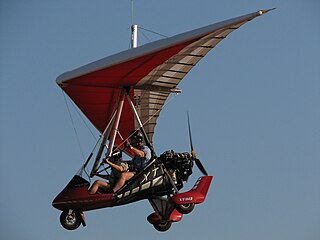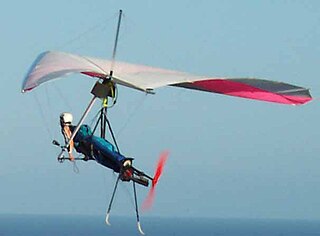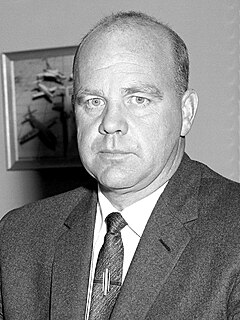Related Research Articles

Hang gliding is an air sport or recreational activity in which a pilot flies a light, non-motorised foot-launched heavier-than-air aircraft called a hang glider. Most modern hang gliders are made of an aluminium alloy or composite frame covered with synthetic sailcloth to form a wing. Typically the pilot is in a harness suspended from the airframe, and controls the aircraft by shifting body weight in opposition to a control frame.

A wing is a type of fin that produces lift while moving through air or some other fluid. Accordingly, wings have streamlined cross-sections that are subject to aerodynamic forces and act as airfoils. A wing's aerodynamic efficiency is expressed as its lift-to-drag ratio. The lift a wing generates at a given speed and angle of attack can be one to two orders of magnitude greater than the total drag on the wing. A high lift-to-drag ratio requires a significantly smaller thrust to propel the wings through the air at sufficient lift.

A fixed-wing aircraft is a heavier-than-air flying machine, such as an airplane, which is capable of flight using wings that generate lift caused by the aircraft's forward airspeed and the shape of the wings. Fixed-wing aircraft are distinct from rotary-wing aircraft, and ornithopters. The wings of a fixed-wing aircraft are not necessarily rigid; kites, hang gliders, variable-sweep wing aircraft and airplanes that use wing morphing are all examples of fixed-wing aircraft.

The Rogallo wing is a flexible type of wing. In 1948, Francis Rogallo, a NASA engineer, and his wife Gertrude Rogallo, invented a self-inflating flexible wing they called the Parawing, also known after them as the "Rogallo Wing" and flexible wing. NASA considered Rogallo's flexible wing as an alternative recovery system for the Mercury and Gemini space capsules, and for possible use in other spacecraft landings, but the idea was dropped from Gemini in 1964 in favor of conventional parachutes.

Francis Melvin Rogallo was an American aeronautical engineer inventor born in Sanger, California, U.S. Together with his wife, he is credited with the invention of the Rogallo wing, or "flexible wing", a precursor to the modern hang glider and paraglider. His patents were ranged over mechanical utility patents and ornamental design patents for wing controls, airfoils, target kite, flexible wing, and advanced configurations for flexible wing vehicles.
Kite types, kite mooring, and kite applications result in a wide variety of kite control systems. Contemporary manufacturers, kite athletes, kite pilots, scientists, and engineers are expanding the possibilities.
Taras Kiceniuk Jr. is a hang glider pioneer from southern California.

An ultralight trike is a type of powered hang glider where flight control is by weight-shift. These aircraft have a fabric flex-wing from which is suspended a tricycle fuselage pod driven by a pusher propeller. The pod accommodates either a solo pilot, or a pilot and a single passenger. Trikes grant affordable, accessible, and exciting flying, and have been popular since the 1980s.

Hang gliding is an air sport employing a foot-launchable aircraft known as a hang glider. Typically, a modern hang glider is constructed of an aluminium alloy or composite-framed fabric wing. The pilot is ensconced in a harness suspended from the airframe, and exercises control by shifting body weight in opposition to a control frame.

The NASA Paresev was an experimental NASA glider aircraft based upon the kite-parachute studies by NASA engineer Francis Rogallo.

A foot-launched powered hang glider (FLPHG), also called powered harness, nanolight, or hangmotor, is a powered hang glider harness with a motor and propeller in pusher configuration. An ordinary hang glider is used for its wing and control frame, and the pilot can foot-launch from a hill or from flat ground, needing a length of about a football field to get airborne, or much less if there is an oncoming breeze and no obstacles.

Paul F. Bikle was director of the U.S. National Aeronautics and Space Administration (NASA) Dryden Flight Research Facility from 1959 until 1971, and author of more than 40 technical publications. He was associated with major aeronautical research programs including the hypersonic X-15 rocket plane, and was a world record-setting glider pilot.

The Ryan XV-8 Flexible Wing Aerial Utility Vehicle was an improved version of the Flex-Wing. Both aircraft were built by Ryan Aeronautical Company in collaboration with NASA for the United States Air Force and the United States Army and tested in 1961 as a STOL patrol, reconnaissance, and light utility aircraft to transport people or freight when a more specialized aircraft is not required or available.

A glider is a fixed-wing aircraft that is supported in flight by the dynamic reaction of the air against its lifting surfaces, and whose free flight does not depend on an engine. Most gliders do not have an engine, although motor-gliders have small engines for extending their flight when necessary by sustaining the altitude with some being powerful enough to take off by self-launch.
Barry Hill Palmer is an American aeronautical engineer, inventor, builder and pilot of the first hang glider based on the Rogallo wing or flexible wing. Palmer also designed, built and flew the first weight-shift ultralight trike aircraft.

Kites are tethered flying objects which fly by using aerodynamic lift, requiring wind for generation of airflow over the lifting surfaces.
The Flight Dynamics Flightsail VII was a recreational aircraft marketed in the United States in the 1970s for homebuilding by Flight Dynamics, Inc., most unusual both in its design and its method of construction. The Flightsail VII was intended to be built in three stages, with each stage representing a flyable aircraft of increasing complexity, capability, and cost. It was hoped that this approach would appeal to homebuilders by minimizing the amount of time and money required to take the aircraft to a point where it could be flown.

John Wallace Dickenson is an Australian inventor, who developed some liquid flow measuring devices and designed a successful hang glider configuration, for which he was awarded with the Gold Air Medal, the highest award given by the Fédération Aéronautique Internationale, the world governing body for air sports, aeronautics and astronautics world records.

In aeronautics, a flexible wing is an airfoil or aircraft wing which can deform in flight.
The Purcell Flightsail or Flight Dynamics Flightsail is an experimental towed glider by Thomas H. Purcell, Jr. He sold plans in several publications for the tow-launched hung-mass controllable kite-glider. He flew first off water in late 1961 and then arranged things for off-land and landing on land. His efforts would find similarity echo later in early 1963 by the SkiPlane of Mike Burns.
References
- ↑ Richard Hallion (1984). On the Frontier: Flight Research at Dryden, 1946-1981. Scientific and Technical Information Branch, National Aeronautics and Space Administration. p. 138. Retrieved 14 February 2021.
- ↑ "NASA Dryden Paresev Photo Collection". Archived from the original on 2008-09-21. Retrieved 2008-10-01. NASA Dryden Paresev Photo Collection
- ↑ Charles Richard and his key designing is noted in the 407 page online-available book On the Frontier at https://history.nasa.gov/SP-4303.pdf
- ↑ "Aviation News Magazine - the Transall C.160". Archived from the original on 2007-09-27. Retrieved 2010-01-09. Aviation Journal's Aviation News, The Rogallo Parasev: A revolution in flying wings
- ↑ "Archived copy". Archived from the original on 2011-05-20. Retrieved 2008-10-01.
{{cite web}}: CS1 maint: archived copy as title (link) NASA Images Detail View - ↑ "Stardust - NASA's Comet Sample Return Mission".